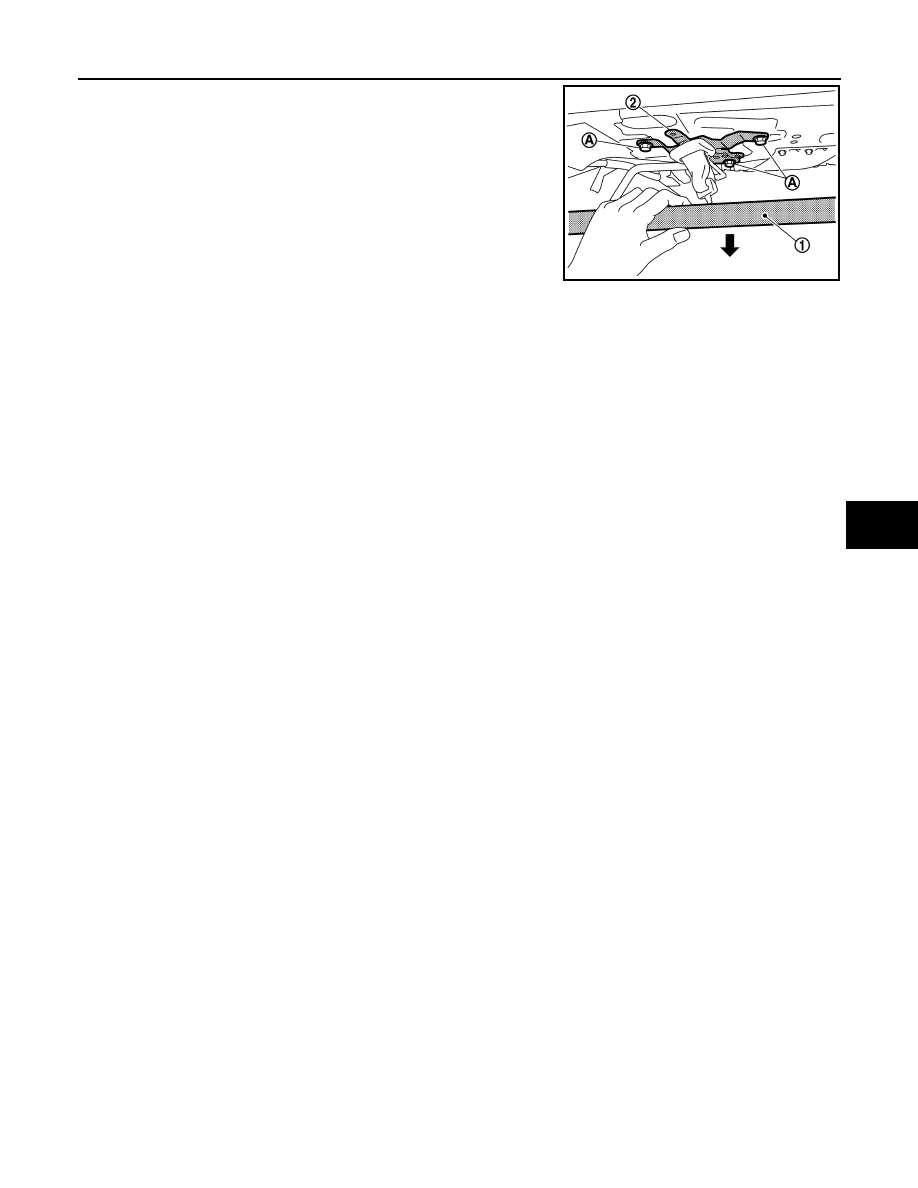Content .. 1040 1041 1042 1043 ..
Nissan Quest E52. Manual - part 1042

THIRD SEAT BELT
SB-17
< REMOVAL AND INSTALLATION >
C
D
E
F
G
I
J
K
L
M
A
B
SB
N
O
P
b.
Slightly lower the headlining assembly (1) rear and secure work
space.
c.
Remove outer seat belt retractor mounting anchor bolts (A), and
then remove outer seat belt retractor (2).
INATALLATION
Install in the reverse order of removal.
SEAT BELT RETRACTOR : Inspection
INFOID:0000000009650628
AFTER A COLLISION
WARNING:
Inspect all seat belt assemblies including retractors and attached hardware after any collision.
NISSAN/INFINITI recommends that all seat belt assemblies in use during a collision be replaced
unless the collision was minor and the belts show no damage and continue to operate properly. Fail-
ure to do so could result in serious personal injury in an accident. Seat belt assemblies not in use dur-
ing a collision should also be replaced if either damage or improper operation was noted. Seat belt
pre-tensioners should be replaced even if the seat belts were not in use during a frontal collision in
which the air bags were deployed.
Replace any seat belt assembly (including anchor bolts) if:
• The seat belt is in use at the time of a collision (except for minor collisions and the belts, retractors and buck-
les show no damage and continue to operate properly).
• The seat belt is damaged in an accident (i.e. torn webbing, bent retractor or guide, etc.).
• The seat belt attaching point is damaged in an accident. Inspect the seat belt attaching area for damage or
distortion and repair if necessary before installing a new seat belt assembly.
• Anchor bolts are deformed or worn out.
• The seat belt pre-tensioners must be replaced even if the seat belts were not in use during the collision in
which the air bags were deployed.
PRELIMINARY CHECKS
1.
Check that the seat belt retractor, seat belt anchor and buckle bolts are tightened firmly.
2.
Check retractor operation:
a.
Fully extend the seat belt webbing and check for twists, tears or other damage.
b.
Allow the seat belt to retract. Check that webbing returns smoothly and completely into the retractor. If the
seat belt does not return smoothly, wipe the inside of the loops with a clean paper cloth. Dirt build-up in the
loops of that upper anchors can cause the seat belts to retract slowly.
c.
Fasten the seat belt. Check that seat belt returns smoothly and completely to the retractor. If the webbing
does not return smoothly, the cause may be an accumulation of dust or dirt. Use the “SEAT BELT TAPE
SET” and perform the following steps.
3.
Repeat steps above if necessary to check the other seat belts.
SEAT BELT RETRACTOR ON-VEHICLE CHECK
Emergency Locking Retractors (ELR) and Automatic Locking Retractors (ALR)
NOTE:
All seat belt retractors are Emergency Locking Retractors (ELR) type. In an emergency (sudden stop) the
retractor will lock and prevent the webbing from extending any further. All 3-point type seat belt retractors
except the driver seat belt also have an Automatic Locking Retractors (ALR) mode. The ALR mode (also
called child restraint mode) is used when installing child seats. The ALR mode is activated when the seat belt
is fully extended. When the webbing is then retracted partially, the ALR mode automatically locks the seat belt
in a specific position so the webbing cannot be extended any further. To cancel the ALR mode, allow the seat
belt to fully wind back into the retractor.
JMHIA1727ZZ